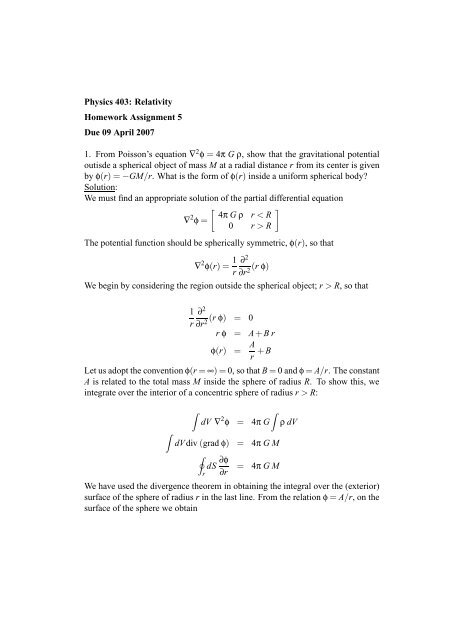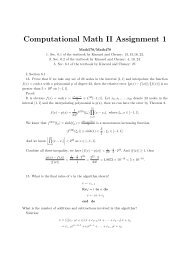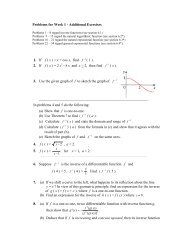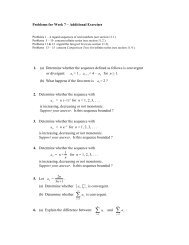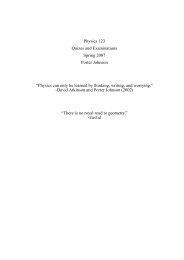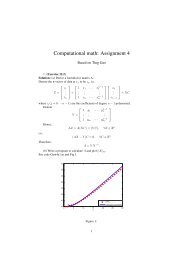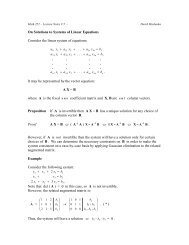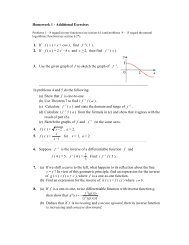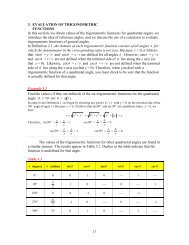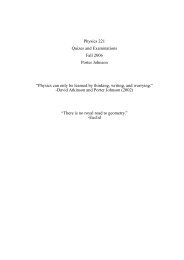Physics 403: Relativity Homework Assignment 5 Due 09 April 2007 ...
Physics 403: Relativity Homework Assignment 5 Due 09 April 2007 ...
Physics 403: Relativity Homework Assignment 5 Due 09 April 2007 ...
- No tags were found...
Create successful ePaper yourself
Turn your PDF publications into a flip-book with our unique Google optimized e-Paper software.
<strong>Physics</strong> <strong>403</strong>: <strong>Relativity</strong><strong>Homework</strong> <strong>Assignment</strong> 5<strong>Due</strong> <strong>09</strong> <strong>April</strong> <strong>2007</strong>1. From Poisson’s equation ∇ 2 φ = 4π G ρ, show that the gravitational potentialoutisde a spherical object of mass M at a radial distance r from its center is givenby φ(r) = −GM/r. What is the form of φ(r) inside a uniform spherical body?Solution:We must find an appropriate solution of the partial differential equation[ ]∇ 2 4π G ρ r < Rφ =0 r > RThe potential function should be spherically symmetric, φ(r), so that∇ 2 φ(r) = 1 r∂ 2∂r2(r φ)We begin by considering the region outside the spherical object; r > R, so that1r∂ 2∂r2(r φ) = 0r φ = A+B rφ(r) = A r + BLet us adopt the convention φ(r = ∞) = 0, so that B = 0 and φ = A/r. The constantA is related to the total mass M inside the sphere of radius R. To show this, weintegrate over the interior of a concentric sphere of radius r > R:ZZdV ∇ 2 φZ= 4π GdVdiv (grad φ) = 4π G MIdS ∂φ = 4π G M∂rrρ dVWe have used the divergence theorem in obtaining the integral over the (exterior)surface of the sphere of radius r in the last line. From the relation φ = A/r, on thesurface of the sphere we obtain
so thatIr∂φ∂r = − A r 2dS ∂φ∂r = − A rIr2 dS = − A r 2 (4π r2 ) = −4π A = 4π G MThus A = −G M, so that for r > R we haveφ(r) = − G MrNote that the total mass M inside the sphere is given in terms of its density ρ byM = 4π 3 R3 ρNext we consider the potential inside the sphere; r < R:∂ 2∇ 2 φ = 1 3 G Mr ∂r2(r φ) = 4π G ρ =R 3∂ 2 3 G M∂r2(r φ) =R 3 rrφ = G M2R 3 r3 +C+ D rφ= G M2R 3 r2 + C r + DWe must match both φ(r) and φ ′ (r) = ∂φ/∂r at the surface r = R. We obtainG M2R + C R + DM= φ(R) = −GRG MR 2 − C R 2 = φ ′ (R) = G MR 2Thus, C = 0 and D = −3GM/(2R). The potential inside the sphere isφ(r) = − G MR3R 2 − r 22R 2
The potential at r = 0, the center of the sphere, is φ(0) = −3GM/(2R).2. A spacetime has the metricds 2 = d(ct) 2 − a 2 (ct) (dx 2 + dy 2 + dz 2 )Show that the only non-zero Christoffel symbols areΓ 0 11 = Γ0 22 = Γ0 33 = a ȧΓ 1 10 = Γ2 20 = Γ3 30 = ȧaDeduce that particles may be at rest in such a spacetime, and that for such particlesthe coordinate t is their proper time. Show further that the nonzero componentsof the Ricci tensor areR 00 = −3äaR 11 = R 22 = R 33 = a ä+2 ȧ 2Hence show that the scalar curvature is(ä )R = −6a + ȧ2a 2Solution:Let us write the line element in terms of (x 0 ,x 1 ,x 2 ,x 3 ):ds 2 = d(x 0 ) 2 − a 2 (x 0 ) [ (dx 1 ) 2 +(dx 2 ) 2 +(dx 3 ) 2 ]The (non-vanishing) diagonal components of the metric tensor areg 00 = 1/g 00 = 1g 11 = 1/g 11 = −a 2 (x 0 )g 22 = 1/g 22 = −a 2 (x 0 )g 33 = 1/g 33 = −a 2 (x 0 )For the Christoffel symbols (along with symmetric partners) we obtain
Γ 0 11 = 1 2 g00 [−∂ 0 g 11 ]= − 1 2 (−∂ 0 a 2 ) = a ȧΓ 0 11 = Γ0 22 = Γ0 33= a ȧΓ 1 01 = 1 2 g11 (∂ 0 g 11 )= − 1 (−∂02a 2 a 2) = ȧaΓ 1 01 = Γ2 02 = Γ3 03 = ȧaLet us calculate the components of the Riemann tensorR 1 010 = −∂ 0 Γ 1 01 − Γ1 01 Γ1 01( ȧ) (ȧ ) 2= −∂ 0 − = −äa a aR 1 010 = R2 020 = R3 030= −äaR 0 101 = ∂ 0 Γ 0 11 + Γ0 11 Γ1 10= ∂ 0 (aȧ)+(a ȧ) ȧa = a ä+2ȧ2R 0 101 = R0 202 = R0 303 = a ä+2ȧ 2The non-vanishing components of the Ricci tensor areR 00 = R 1 010 + R 2 020 + R 3 030 = −3äaR 11 = R 0 101 = a ä+2ȧ 2R 22 = R 0 202 = a ä+2ȧ 2R 33 = R 0 303 = a ä+2ȧ 2
The scalar curvature isR = g 00 R 00 + g 11 R 11 + g 22 R 22 + g 33 R 33= −3äa − 3 (ȧa 2(a ä+2ȧ2 ) = −6äa − 6 aParticles move along “geodesic line” trajectories that satisfy the geodesic eauation:d 2 u αds 2+ Γα βγdu βdsdu γds = 0Is the trajectory for a particle at rest, u α = (x 0 = s,x a = x a 0) a solution of thegeodesic equation? That is, are the following equations satisfied?) 2Putting the condition dxbdsWe obtain the solutiond 2 x 0ds 2 + dx b dx bΓ0 bbds dsd 2 x ads 2 + dx 0 dx aΓa 0ads ds= 0= 0= 0 into these equations, we obtainx 0d 2 x 0ds 2 = 0d 2 x ads 2 = 0= x 2 0 + b sx a = x a 0Thus, a particle may remain at rest at any location in this metric.3. In Schwarzschild geometry, we introduce the new coordinatesxyz= r sinθ cosφ= r sinθ sinφ= r cosθ
Find the form of the line element in these coordinates.Solution:The Euclidean line element may be written in either Cartesian coordinates orspherical polar coordinates:Equivalently, we obtaindx 2 + dy 2 + dz 2 = dr 2 + r 2 (dθ 2 + sin 2 θ dφ 2 )r 2 (dθ 2 + sin 2 θ dφ 2 ) = dx 2 + dy 2 + dz 2 − dr 2Furthermore, it follows from the relation for r(x,y,z), r 2 = x 2 + y 2 + z 2 , thatorrdr = xdx+ydy+zdzdr 2 = (xdx+ydy+zdz)2r 2Thus, we may express the Schwarzschild line element asds 2 = (1 − 2R r )(cdt)2 − dr21 − 2R/r − r2 (dθ 2 + sin 2 θ dφ 2 )= (1 − 2R [ ]r )(cdt)2 − dr 2 11 − 2R/r − 1 − dx 2 − dy 2 − dz 2= (1 − 2R r )(cdt)2 − dr 2 2Rr − 2R − dx2 − dy 2 − dz 2= (1 − 2R r )(cdt)2 − (xdx+ydy+zdz)2r 2We write out the term2Rr − 2R − dx2 − dy 2 − dz 2(xdx+ydy+zdz) 2 = x 2 dx 2 + y 2 dy 2 + z 2 dz 2 + 2xz dxdz+2xy dxdy+2yz dydzand obtain the following components of the metric tensor, expressed in terms of(x,y,z) and r = √ x 2 + y 2 + z 2 :
g 00 =[1 − 2R r]g 0a = g a0 = 0[ 2R x 2 ]g xx = −r − 2R r 2 + 1 [ 2R y 2 ]g yy = −r − 2R r 2 + 1 [ 2R z 2 ]g zz = −r − 2R r 2 + 1xyg xy = g yx = − 2Rr − 2Rg xz = g zx = − 2Rr − 2Rg yz = g zy = − 2Rr − 2RNote that the Schwarzschild metric is considerably more complicated in Cartesianspatial coordinates than for polar coordinates.4. Consider a spacetime with metricwhere the parameter a is constant.• Find all the Christoffel symbolsr 2xzr 2yzr 2ds 2 = e −2ax dt 2 − dx 2 − dy 2 − dz 2• Find the geodesic equations for x(t), and show that for instantaneous zerovelocity, the x component varies with uniform acceleration a, as though theparticle were in a uniform gravitational field.• Determine the components of the Riemann tensor R 1 001 ,R0 110 ,R1 010 ,R0 101 , andshow that the rest are zero.• From the Einstein field equations find the diagonal elements of the energymomentum tensor. Is this tensor physically acceptable?
Solution:The nonvanishing components of the metric tensor areg tt = 1/g ttg xx = g xxg yy = g yyg zz = g zz= e −2 a x= −1= −1= −1The following Christoffel (along with symmetric partners) are non-zero:Γ x tt = 1 2 gxx [−∂ x g tt ] = − 1 2[2 a e−2 a x ] = −a e −2 a xΓ t xt= 1 2 gtt [∂ x g tt ] = 1 2 e2 a x[ − 2a e −2 a x] = −aIn turn, these components of the Riemann tensor (along with antisymmetric partners)are non-vanishing:R t xtxR x txt= −Γ t xt Γt tx = −a2= ∂ x Γtt x − Γtt x Γ t xt = 2a 2 e −2 a x − a 2 e −2 a x = a 2 e −2 a xThe following components of the Ricci tensor are non-zero:R xxR tt= R t xtx = −a2= Rtxt x = a 2 e −2 a xThus we may compute the scalar curvature:R = g xx R xx + g tt R tt = 2a 2The Einstein field equations have the formR µν − 1 2 g µν R = κ T µν
If the particle starts from rest at x = x 0 , its proper speed v over short distancessatisfies the relation corresponding to uniform acceleration:v 2 = 2a(x − x 0 )5. Determine the surface area of a sphere in n-dimensional Euclidean space bycarrying out the following steps:• The surface area of an n-dimensional sphere of radius r is S n (r) = a n r n−1 ,where a n is independent of the radius r. Why?• Show thatJ =Z ∞−∞√πdx e −ax2 =a• Express J n as an integral over Cartesian coordinates (x 1 ,x 2 ,···,x n ) in n-dimensional Euclidean space.• Express J n as an integral over the coordinate r, where r 2 = x 2 1 +x2 2 +···+x2 n.• Evaluate that integral over r, and thus determine the factor a n in the surfacearea of an n-sphere.Solution:Let us begin by writing J 2 as a two-dimensional integral:J 2 =Z ∞−∞Z ∞dx e −ax2 dy e −ay2We transform this two-dimensional integral in polar coordinates:J 2 =Z ∞0−∞Z 2πr e −ar2 dr dθ = π Z ∞ [d −e −ar2] = π0 a 0aTaking the positive square root, we determine J = √ π/a. Next we express J n asan integral over n-dimensional space, which we transform to polar coordinates,defining√r = x 2 1 + x2 2 + ···+x2 n
We obtainJ n =Z ∞0e −ar2 S n (r) drwhere S n (r) is the area of an n-dimensional spherical hypersurface of radius r.The volume of an n-dimensional sphere of radius R is given by this integral overCartesian coordinates:ZV n (R) =dx 1dx 2 ···dx nx 2 1 +x2 2 +···+x2 n ≤R2Let us express this volume as an integral over scaled coordinates t i = x i /R:V n (R) = R n Zt 2 1 +t2 2 +···+t2 n≤R 2 dt 1dt 2 ···dt n ≡= v n R nsince the integration over t i is independent of R. We may write this volume integralasso thatV n (R) =Z R0drS n (r)S n (r) = s n r n−1 = nv n r n−1Consequently,[ π n/2Z ∞J n = = sn ea] −ar2 r n−1 drWe define the variable u = ar 2 to transform that integral:J n =s Zn2a n/2 u n/2−1 e −u duUsing the definition of the Euler Gamma function,0we obtain the resultΓ(z) =Z ∞0u z−1 e −u du
ds 2= ds 2 t − ds2 r − ds2 θ − ds2 φ= (1 − 2R r )(cdt)2 − dr21 − 2R/r − r2 (dθ 2 + sin 2 θ dφ 2 )The volume of the region between radius r = 2R and r = r ′ isV(r ′ ) =Zds rZds θZds φ =Z r ′r 2 dr= 4π √2R 1 − 2R/rZ r ′2RZdr π√ r dθ1 − 2R/rLet us define the variable u = 2R/r, so that dr = −2Rdu/u 2 andV(r ′ ) = 32π R 3 Z 1u ′0du 1u 4 √ 1 − uZ 2π0r sinθ dφwhere the upper limit is u ′ = 2R/r ′ . We define the angular variable ρ by therelation u = cos 2 ρ, so that du = −2cosρ sinρ dρ and0Z ρ ′V = 64πR 3 sec 7 ρ dρwhere cos 2 ρ ′ = u ′ = 2R/r ′ .The integral may be evaluated in closed form 1Z ρ ′[ 1sec 7 ρ dρ = tanρ ′ secρ ′ 6 sec4 ρ ′ + 5 24 sec2 ρ ′ + 5 ]+ 516 16 ln[ tanρ ′ + secρ ′]Consequently, the volume V(r ′ ) is( √r 1V(r ′ ) = 4π[ ′ (r ′ − 2R)3 r′2 + 5 6 r′ R+ 5 ) [√2 R2 + 5√ )]r16 ln ′ r2R + ′ − 2R2RIn the limit r ′ >> 2R, this volume approaches the “flat space” limit, V(r ′ ) =4πr ′3 /3. The volume between radii r 2 and r 1 is V(r 2 ) −V(r 1 ).1 Gradshteyn and Ryzhik, Table of Integrals, Series, and Products (1965), 2.526.15, p. 1370


